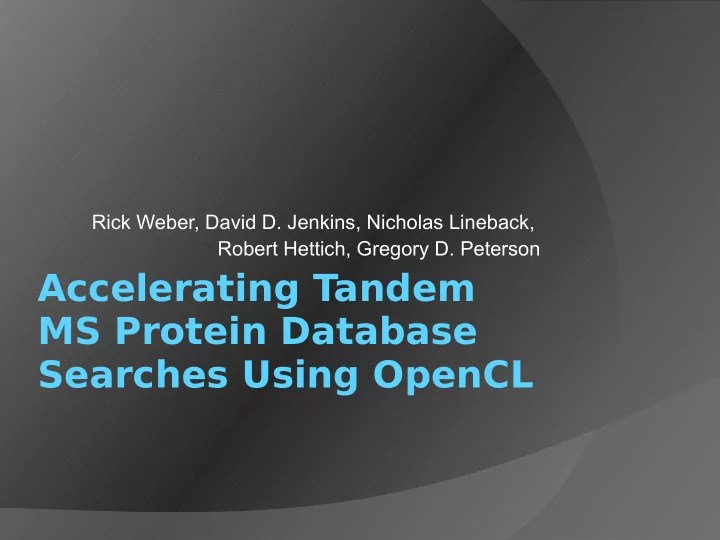

Rick Weber, David D. Jenkins, Nicholas Lineback, Robert Hettich, Gregory D. Peterson Accelerating Tandem MS Protein Database Searches Using OpenCL
Programming devices the intractable way
Programming devices with OpenCL
T andem MS/MS experiment Collect a sample Clean it Try to remove things that aren’t proteins Dissolve proteins into peptides Trypsin Shoot mixture through mass spectrometer Mass spectrometer gives ~100k scans containing m/Z and intensities
Peptide searching with database
Search algorithms Mostly differ in the scoring algorithm Consequently, different execution rates Sequest Cross correlation Most widely used X! Tandem Dot product Myrimatch Multi-Variate Hypergeometric (MVH) distribution
Specmaster OpenCL Myrimatch implementation Runs correctly on AMD, Nvidia GPUs; AMD, Intel CPUs Not tested anything else Designed from ground up for speed Myrimatch already multi-threaded No 400x speedup using GPU 10x is more reasonable
Algorithm design Make peptides from proteins sequentially on CPU Needs to be done in OpenCL (future work) Amdahl’s law Perform search using OpenCL devices Each workgroup processes different MS2+ scan Each work item searches a different candidate
Search Binary search for candidates Precursor masses within tolerance for assumed charge state Binary search for ions Look for peaks theoretically predicted for peptide’s amino acid in multiple charge states Compute MVH as a function of number of found peaks by intensity class
OpenCL and the lack of free lunch Little performance portability Different devices have: Different memories Different SIMD sizes Different branch penalties Different execution models
Memory speeds __constant __local __global __global (cached) (raw) E5-2680 518GB/s 425GB/s 469GB/s 51GB/s GTX 480 1.29TB/s 1.3TB/s 588GB/s 152GB/s Radeon 7970 7TB/s 3.6TB/s 1.7TB/s 213GB/s
Preferred work group sizes CPU: 1 AMD GPU: multiple of 32 or 64 Nvidia GPU: multiple of 32 or 64
Peformance (as of time of publication)
“Future work” already completed Portable device specific tuning Still running with same kernel code on all devices! Preprocessor abuse Kernel apathetic to work group size Heterogeneous scan scoring Use every device in CPU to score Up to 90% of peak strong-scaled throughput using 32 cores and 3 Radeon 7970s
Actual future work Post translational modifications When generating peptides, create each modified variant of pepties on CPU Easy (Don’t need to modify kernels) Probably slow Take existing unmodified list and modify on the fly on the device Hard due to lack of recursion in OpenCL Amortizes sequential execution and PCIe transfers
Acknowledgements The University of Tennessee NSF and SCALE-IT Intel For donating the research machine
Questions?
Recommend
More recommend